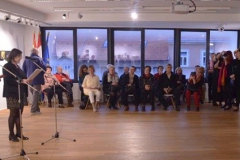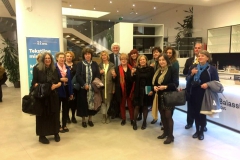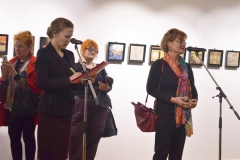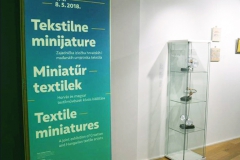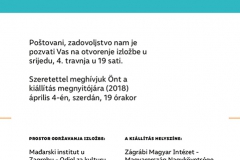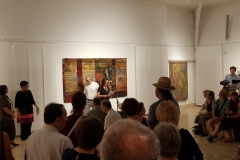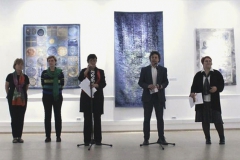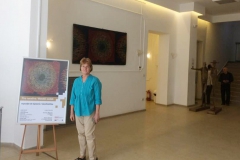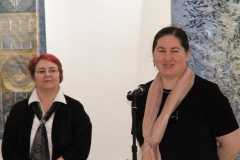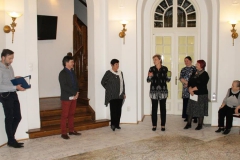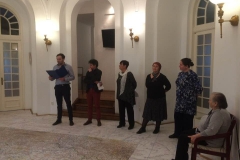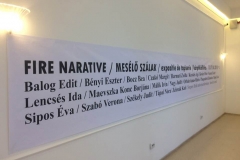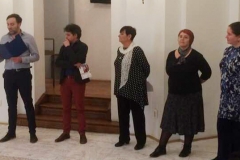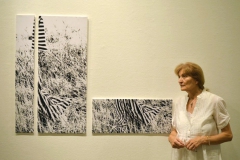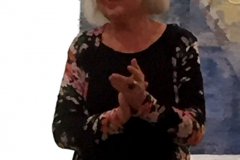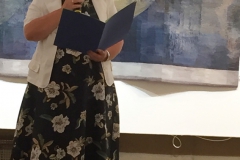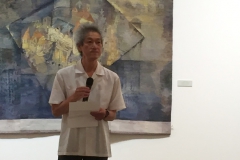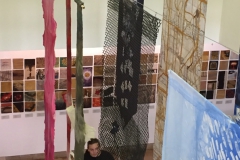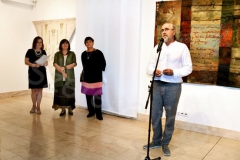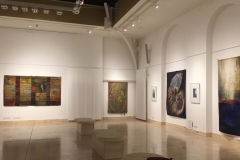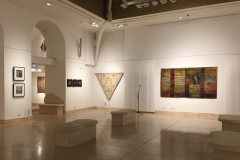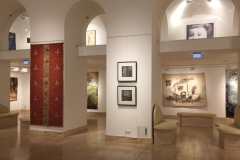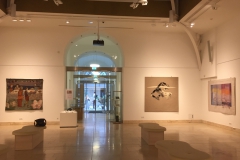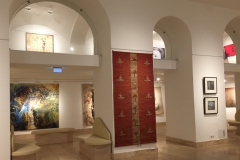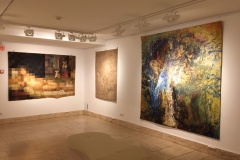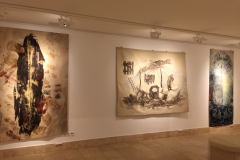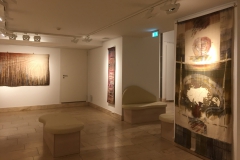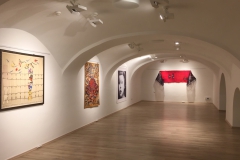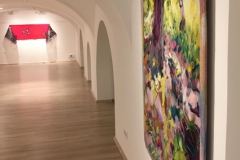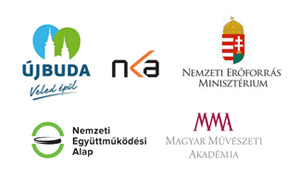2018
Minitextilek Balassi Intézet, Zágráb
Minitextilek
ZÁGRÁB BALASSI INTÉZET 2018.04.04.
LENCSÉS IDA
Ferenczy Noémi-díjas kárpitművész
a Magyar Kárpitművészek Egyesületének alelnöke megnyitó beszéde
Tisztelt Hölgyeim és Uraim, kedves Kiállítóművészek!
A Magyar Kárpitművészek Egyesülete immár másod ízben állít ki itt a Balassi Intézetben. Az elmúlt évben mutatkoztunk be Önöknek egy reprezentatív kiállítás keretében és most nagy örömünkre szolgál, hogy az első kapcsolat eredményeként újból itt lehetünk.
Az idei közös kiállításnak izgalmas mondanivalója van. A magyar művészek klasszikus szövéssel készült miniatűr munkáinak találkozása a horvát művészek konceptuális, experimentális textil objektjeivel, amelyek térbe sűrítve mondják el üzenetüket mai világunkról.
Budapesten 2017. áprilisában, Kárpit3 címmel nemzetközi kiállítást szerveztünk, melyen 17 ország művészeinek 35 nagyméretű alkotása szerepelt. Az egyesület tagjai és a külföldi művészek Aranyfal címen 105 darab 20×20 centiméteres mini textilt állított ki az összefogás jelképeként. Ebből mutatunk be Önöknek 32 művet.
A Magyar Kárpitművészek Egyesülete 1996-ban alakult, több mint nyolcvan tagot összefogó művészeti szervezetté bővült, mely az európai gyakorlathoz mérten nagyszámú közösségnek tekinthető. Összefogja és képviseli a hazai tagság mellett a határon túli, illetve ma is külföldön élő tagjainkat. A Magyar Kárpitművészek Egyesülete eddig több mint száz nemzetközi és hazai kiállítás résztvevője és rendezője volt, melyek közül a legjelentősebbek a washingtoni Textil Múzeumban, Genfben- az ENSZ székházában, majd a kanadai Vancouverben és az olaszországi Ceri-ben a Magyar Kulturális Év alkalmából rendezett tárlatok.
Jelentős eseményként említhető még a budapesti Iparművészeti Múzeumban bemutatott Transzcendens térképek című kiállítás, melyen az Egyesület alapításának 15. éves jubileuma alkalmából, hatvan művész vett részt.
Szövés-kódok címmel, a budapesti Francia Intézetben létrehozott kiállítás pedig főként az egyéni alkotások minél gazdagabb bemutatására összpontosított.
Az egyesület szervezője és házigazdája volt a Kárpit 1. és Kárpit 2. nagyszabású nemzetközi kiállításoknak a budapesti Szépművészeti Múzeummal közösen. A Kárpit3. kiállítás előkészítésére „Apokalipszis vagy fenntarthatóság” címen konferenciát szerveztünk és az elmúlt évben kiállítást rendeztünk a Vigadó Galériában.
Büszkék vagyunk az Európa Tanács Székházában, Strasbourgban rendezett kiállításunkra, és arra, hogy munkáink által tiszteleghettünk a marosvásárhelyi Kultúrpalota fennállásának centenáriumán és a római Magyar Akadémián, amikor 20 éves lett az egyesület és művészeinknek is szólt azaz elismerés amikor a Milánó-i Expo Magyar Pavilonjában több mint húsz millióan láthatták közös alkotásainkat.
Egyedülálló teljesítmény a közösen alkotott nyolc nagyméretű művünk. (Kárpit határok nélkül, Szent István és műve, Corvin kárpitok, Transzcendens térképek, Duna-Limes, Petőfi -,,…keresztül szőtték-fonták szívemet”…, Hommage a Radnóti és a Szent László triptichon.
A monumentális kárpitok lehetőséget teremtenek az együttalkotásra, az alkotói öntörvényűség és a közös munka kényszereiből fakadó alázat egyesítésére. A nagyméretű művek létre hozását a művészettörténeti értéket is jelentő szövőszékek „örökbefogadása” tette lehetővé, ami sajátos hagyományőrző szerepet is kínált a közösség számára. Így az Egyesület ennek a műfajnak a tárgyi hagyatékát, muzeális értékeket megóvó, és gyakorlatban is hasznosító, értékteremtő tevékenységével kiemelt szerepkörhöz jutott az egyetemi oktatás területén is. A hagyományos kárpitszövés műfaja egyesíti a tervező, a kartonkészítő és a kivitelező szövő gyakorlatát, ezt a gyakorlatot ápolja a műfaj professzionális művelőit összefogó, és a lehetséges fórumokon képviselő Egyesület.
Hasonlóan nagy figyelmet fordítunk a mini textilek ügyére. A mini textil megalkotása kreatív kihívás, és a kicsiny méret különös helyzetet teremt a kárpitművész számára. Ez a műfaj megengedi, hogy a hirtelen ötletet megpróbáljuk kivitelezni, akár grafikai, akár térplasztikai jellegű.
Az ünnepi alkalmat megragadva, ezúton kérjük fel a Horváth Iparművészek Egyesülete tagjait (ULUPUH), hogy látogassanak el hozzánk Budapestre és tekintsék meg a most készülő Szent László kárpitunk kivitelezését, és közösen gondolkodjunk egy újabb kiállítás megrendezésén.
Köszönetet mondunk az
ULUPUH-nak, hogy a közös kiállítás katalógusának, valamint a plakát tervezésének és elkészítésének munkálatait magukra vállalták.
Külön köszönetemet fejezem ki a kiállítás létrejöttéért
Dr. Szlanyinka Anna kulturális attasénak és a Balassi Intézet munkatársainak,
az ULUPUH művészeinek és munkatársainak,
a Magyar Kárpitművészek Egyesülete művészeinek,
Branka Hlevnjak és Tápai Nóra kurátoroknak,
a kiállítás rendezőinek: Branka Hlevnjaknak, Tanja Grgurina Vuceticnek,
Kneisz Eszternek és Tápai Nórának, Kovács Tibornak a MANK művészeti főtanácsadójának, a kiállítás védnökeinek és a támogató szervezeteknek.
Engedjék meg, hogy az itt jelenlévő magyar kiállítóművészeket bemutassam:
Baráth Hajnal, Ipacs Hajnal, Kiss Kati, Máder Indira, Kneisz Eszter,
Lencsés Ida, Pápai Lívia, Pasqualetti Eleonóra, Sipos Éva, Székelyi Judit,
Tápai Nóra, Zelenák Katalin.
Szép Galéria
Bonds and Ties
Association of Hungarian Tapestry Artists
Exhibition: 2018.08.02-09.01, „Széphárom” Communuty Hall, 1053 Budapest, Szép street 1 / b.
„Széphárom” Community Hall 2018.08.02-09.01 We present in this exhibition a representative collection of artworks created by the 30 members of the Association of Hungarian Tapestry Artists founded 22 years ago. There is no particular theme in the exhibition, we just want to demonstrate quality and diversity. The Széphárom is probably the most beautiful exhibition hall in the V. district, where our exhibition will be visible for a month.
Ida Lencsés
Vice-President of the Association of Hungarian Tapestry Artists, curator of the exhibition
Stories in the Threads, Sofia, Bulgaria
Sofia, Bulgaria
Ladies and gentlemen, I’d like to welcome you to the Association of Hungarian Tapestry Artists’s group exhibition called Stories in the Threads!
The Association of Hungarian Tapestry Artists, with its over 80 members, collects and represents artists of the craft from Hungary to Hungarians beyond the borders. Saying that this dynamic association is one of the most organized art groups today in Hungary cannot be called an overstatement. In this welcoming and warm community members receive inspiration and opportunities to exhibit and take part in community workshops. Proving this is the eight imposing tapestry created in unity by the artists.
The artworks of this exhibition represent the artistic and stylistic diversity of the tapestry artists. Although 1970 marked an attempt at modernization in the history of Hungarian tapestry, by the mid-1990s, at the time of the association’s foundation, most of the artists have turned back to the traditional tapestry roots. This phenomenon, even if not conscious, it represented a sharp U-turn back to the academic founder of the art form in Hungary. Back, to one of the most important figures of the 20th century Hungarian tapestry art, Noémi Ferenczy and her concepts on medieval ideals. According to her, the real value of the tapestry is the time and dedication to the material and the artist’s handprint. This means that tapestry can be interpreted as the art form of man’s rule over time. Tapestry is basically a protest against the machine civilization that accelerates the passage of time. Processing it allows its creator to “snap out” of time and enter an out-of-time state. While working, the tapestry artist distances him or herself from the everyday life and becomes fully and thoroughly present. Sacrificing time and energy the artist basically sews him or herself into the tapestry.
Stories in the Threads: the name of this exhibition also references this meta-narrative that is far from implying a detachment or something abstract. It is more like an intimate connection between the object and the threads of the spirit forming it. To quote Noémi Ferenczy once again, “The artwork grows together with the breathing of its creator, together with the creator’s thoughts and perceptions, face to face, in private (…) it cannot be a separate thing or being for it would not only exclude intensity, it would remove intimacy just the same.”1 This togetherness and the “manifestation” of the threads of soul is what can be viewed on the walls, in front of the audience. Faith, one of the greatest mysteries of the human soul, is, just like the creative process, a truly personal question, one of the key motifs of the showcased tapestry. It may appear conceptually, philosophically or in specific Christian symbolisms such as the alpha and omega sign on Irén Málik’s creation or the Christ-corpus on the work of Ágnes Kecskés. Eleonóra Pasqualetti takes her works as autonomic, spiritual mediums. She mostly deals with the symbolism and archetypes of centralization but from right here, from the visible world with a figural approach. Edith Balogh passes the narrative approach or the portrayal of humans creating an abstract, metaphysical space where the vivid colors of transcendental light takes center stage. Wheat-sheaf reaching towards the light across the cages of human souls is the vision appearing on the work of Erzsébet Katona Szabó. Also as symbolism for soul and destiny plants can be seen on the works of Indira Máder, Hajnalka Ipacs and Noémi Benedek. The love-hymn of Paul the Apostle is recreated in the cosmic landscape composition by Eszter Bényi, Judit Székely references the personal search for God with the motifs of prayer and ladders.
Another important group of the figural works is the landscape representations. The temperament and original style of the creator can be measured well in the genre often functioning as a mirror of the soul. The landscape vision by Verona Szabó resembles photographs and maps, while the one by Éva Sipos is more expressive and picturesque. In the third, larger thematic block I’ve listed those works that directly or indirectly connects the human experience or to the perspective of the female narrative. The soul-feather symbolism by Judit Pázmány oe Borjána Maevszka Koncz’s creations are clear representatives of this theme. Lívia Pápai’s work, where she combines the portrait of her son with a Dalí painting into a black and white composition or Katalin Zelenák’s deconstruction of a female portrait delicately illustrates the separation of the present from the renaissance man-ideal.
The exhibition is also home to several works connecting to literacy. Éva Penkala and Annamária Kőszegi was inspired by the poem “I cannot know” by Hungarian poet Miklós Radnóti. Bea Bocz commemorates one of the greatest mystics of 20th century Hungarian Christian literature, János Pilinszky while Katalin Fóris have chosen the poem called “The Seventh” by Attila József as title for her installation woven by film negatives.
Although in smaller numbers, abstract visual thinking is also represented thanks to the work of Ida Lencsés. The private oeuvre can be interpreted through the context of self mythologies as the works of Zsófia Harmati, Eszter Kneisz and Annamária Orbán.
The monumental work created by the Association of Hungarian Tapestry Artists is called the “Colors of Europe”. This title is no coincidence as this strong community can be seen as the guardians of Europe’s former lights, weaving their personal and common destinies with the patience and loyalty of Penelope. For myself and for the exhibiting artists I wish for this exhibition to contribute to the strengthening of the cultural relationship between Bulgaria and Hungary, towards a mutually-supportive cooperation. Thanking your attention, hereby I’m opening the exhibition.
Eszter Molnár



